DAWN
Level A Teacher Manual
Name:
Class:
School:


Name:
Class:
School:

Circle Time Getting Comfortable with the Teacher
General Awareness Knowing Each Other’s Name
Foundational Literacy Picture Discussion: Mira’s First Day at School Literacy Skillbook, pages 1–3
Foundational Numeracy Standing Lines Numeracy Workbook, page 1
DIY Game: Musical Freeze Dance
LO: Children will begin to get comfortable with their teacher.
1. Warm Welcome: Sit in a circle, if possible. Introduce yourself with a big smile and say: Hello, children! My name is Kanika. I am your teacher. I am so happy to meet all of you. We will have lots of fun together!
2. Sharing Fun Things: Tell children some things about yourself that could be fun for them to know. For example: I love to sing songs. / I make very tasty sandwiches. / I love to draw and colour. / I know a lot of games that we can play together.
3. Knowing about Children: Now, ask each child something about them. You can ask any question that does not make them uncomfortable. For example: What is your name? / What do you like to do? / Who dropped you at the school today?
Pro Tip
Many children may feel anxious on the first day of school. Reassure them and be patient. Remember to be kind, gentle and affectionate. Feel free to discuss things in their home language. It instils a sense of emotional security and belonging in children.

LO: Children will be able to tell the class their name.
Resources: Any soft toy
1. Greeting Song: Sing a simple song with repetitive lines to introduce yourself and to encourage the children to introduce themselves. For example: Hello, hello, what’s your name? Hello, hello, what’s your name? My name is Kanika! Sing this song 5-6 times. Encourage children to wave at you and smile when you sing.
2. Name Game: Ask children their name in a sing-song manner, as shown below:
Teacher: Hello, hello, what’s your name? Hello, hello, what’s your name?
Student 1: My name is Viraj.
Teacher: Hello, hello, what’s your name? Hello, hello, what’s your name?
Student 2: My name is Saima.
3. Pass the Toy: Tell the children that they will now play a game. Tell them that you will pass the soft toy around. Whoever holds the toy, says their name loudly. Start with yourself as an example. Hold the toy and say: Hi! My name is Kanika.
Ensure that every children had their turn. You may clap for each child when they say their name.







Help shy children by gently prompting them or letting them repeat after you.
LO: Children will be able to talk about the story Mira’s First Day at School, by looking at its pictures, either in their home language or in a mixed language.
Resources: Literacy Skillbook, pages 1–3
1. Setting the Context: Say: Today, we will talk about a little girl named Mira. Like you all, it’s her first day at the school. Let us see how she feels.


2. Introducing the Characters: Help the children open to page 1 in the book. Then, point to Mira in the picture and tell the class that she is Mira. After that, point to Mira’s mother in the second picture and tell the class that she is Mira’s mother.
Ask simple questions about the pictures. For example:
Picture 1: What is Mira doing? / What is she wearing? / Does she look happy or sad?
Picture 2: What is Mira’s mother doing? / Where do you think they are going?
3. Talking about the Pictures: One you have introduced Mira and her mother, point to every picture and talk about it. Ask questions that will help the children predict the events in the story. For example:
Picture 3: Who else do you see in this picture? / Where are they?





Picture 4: Who do you think is this woman? (Pointing at the woman in pink kurta and specs)
Picture 5: What do you think is happening here?
Picture 6: What is Mira doing? / Why do you think she is crying? / What is her mother doing?
Picture 7: Where is Mira now? / What all do you see in the picture?
Picture 8: Does Mira look happy or sad now? Why?

DO NOT read aloud the story today. Just let the children observe each picture and talk about them freely. Their responses may or may not be correct per the story, but that is okay.
LO: Children will be able to trace standing lines, thereby developing their fine motor skills.
Resources: Numeracy Workbook, page 1
1. Seeing Standing Lines: Draw a large standing line on the board. Say: This is a standing line. It goes straight, up and down. Repeat this line a few times.
2. Air Drawing: Demonstrate standing lines by tracing it in the air with your finger. Then, ask children to trace the standing line in the air with you, at least 5–7 times.
3. Tracing Standing Lines: On page 1 in the workbook, ask children to first trace the dots of the standing lines with their fingers. Then, ask them to trace the standing lines using a crayon or a pencil. Move around to guide, help and encourage children as they trace.
















Find one item at home that resembles a standing line. Bring it to class tomorrow and show it to your friends.
LO: Children will be able to enjoy movement, improve their listening skills, and learn to follow instructions with the help of a game of ‘Musical Freeze Dance’
Resources: A music player or phone with kid-friendly songs (OR you can sing by yourself)
1. The Rules: Explain the rules in simple words. Say: We will play a game called ‘Musical Freeze Dance’. When I sing/play the music, we will dance. When I stop the music and say ‘Freeze!’ loudly, you will freeze like a statue and not move. If needed, demonstrate this by yourself first.
2. Playing the Game: Play lively, kid-friendly music. Let children dance/jump freely when the music is being played. Pause the music suddenly and loudly say, ‘Freeze!’ Praise them when they freeze, even if they are giggling or moving a little.
Circle Time
Importance of School
General Awareness Meet Me
General Awareness, page 2
Foundational Literacy Storytelling: Mira’s First Day at School Literacy Skillbook, pages 1–3
Foundational Numeracy Sleeping Lines Numeracy Workbook, page 2
DIY Colouring: Red, Blue and Yellow
LO: Children will be able to say what they like about their school.
Art and Craft, page 2
1. A Rhyme on School: Start the day with a rhyme on school. Sing this rhyme 4–5 times with the children.
2. The Importance of School: Tell the children about the good things at school. For example, you can say: We can make new friends at school. We can learn new things at school. We can draw and colour in the school books. We can play games, listen to stories, and sing rhymes at school.
Run, run, run, Run to the school. I love my friends, I love my school.
3. Knowing from Children: Finally, ask the children to talk about what they like about school, or what they want to do/learn today. Try to respond to their requests as the day progresses.

LO: Children will be able to tell their name and age.
Resources: General Awareness, page 2
1. Recap: Sing the song that was sung yesterday again. Hello, hello, what’s your name? Hello, hello, what’s your name? My name is Kanika! Then, ask a few children their name in a sing-song manner, as shown below: Teacher: Hello, hello! what’s your name? Hello, hello! what’s your name? Student: My name is Kimaya.
2. Modelling: Next, guide children to say both their name and age aloud. Give an example: My name is Kimaya. I am 3 years old. Ask children to repeat after you 5–6 times.
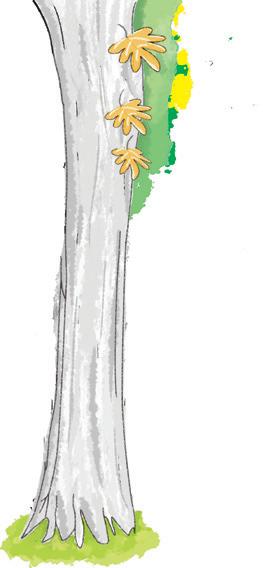

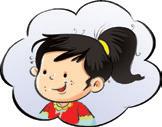


3. Name and Age: Finally, ask each child to stand up or come forward, and tell the class their name and age.

4. Meet Me: Help children open to page 2 in the book. Talk about the pictures and read aloud the text. Let children repeat the lines after you a few times. Finally, guide them to write their names in the book.


Paste your photograph in the given space.





LO: Children will be able to listen to the story Mira’s First Day at School in their home language and mixed language.
Resources: Literacy Skillbook, pages 1–3


1. Revising Circle Time: Revise about why school is important. Then, say: Yesterday, we saw in the pictures that Mira was going to school for the first time. Today, we will listen to her story and know how her first day was at the school.
2. Recap: Help the children open to page 1 in the book. Ask them to point at Mira and her mother in the pictures.
3. Storytelling: Pointing at the pictures in the book, narrate the story Mira’s First Day at School using the children’s home language.
4. Storytelling (in Mixed Language): Next, again pointing at the pictures, narrate Mira’s First Day at School using mixed language, i.e., their home language with English words (happy, books, crayons, school, teacher, hello, classroom, children, inside) mixed into the sentences.
DO NOT start with an English read aloud. Let them listen to the story in their home language and mixed language first, so that they can understand the story well. The story will be read aloud in English on the next day. Error Alert!






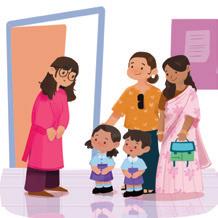



Narrate the story with a lot of expression. Use gestures and voice intonation to make the storytelling interesting. Pause at regular intervals and engage with the children by asking simple recall-and-understanding-based questions. For example: What does Mira pack in her school bag? Who drops Mira to school? What is Mira’s teacher’s name? What are the children doing in the classroom?
LO: Children will be able to trace sleeping lines, thereby developing their fine motor skills.
Resources: Numeracy Workbook, page 2
Ask a few children to come forward and show the object they brought from home that resembles a standing line. Explain how the object is similar to a standing line.
1. Seeing Sleeping Lines: Draw a sleeping line on the board. Say: This is a sleeping line. It goes straight, from left to right! Repeat this line a few times while pointing at the line on the blackboard.
2. Air Drawing: Demonstrate sleeping lines by tracing it in the air with your finger. Then, ask children to trace the sleeping line in the air with you, at least 5–7 times.
3. Tracing Sleeping Lines: On page 2 in the workbook, ask children to first trace the dots of the sleeping lines with their fingers. Then, ask them to trace the sleeping lines using a crayon or pencil. Move around to guide, help and encourage children as they trace.












LO: Children will be more familiar with the red, blue, and yellow colours. They will also learn to colour in circles, thereby developing their fine motor skills.
Resources: Art and Craft, page 2; red, blue, and yellow crayons
1. Colour Introduction: Introduce the colours red, blue, and yellow by showing them the crayons of the same colours. Then, ask them to name the things in their surrounding that are red, blue or yellow. This can be done as a game as well.
2. Colouring: Help children to colour the circles. Help them hold the crayons, wherever required, and guide them to colour inside the shape.


Domain Topic of the Day
Circle Time
Knowing Common Objects in Classroom
General Awareness Boy or Girl
Book & Page
General Awareness, page 3
Foundational Literacy Read Aloud of Mira’s First Day at School Literacy Skillbook, pages 1–3
Foundational Numeracy Right Slanting Lines
DIY Poem: Twinkle Twinkle Little Star
Numeracy Workbook, page 3
LO: Children will be able to identify and tell the use of some common objects in their classroom. Resources: Classroom items like chalk, crayon, book, etc.
1. Setting the Context: Greet the children warmly and say: Today, we will learn the names and uses of objects in our classroom.
2. Showing and Telling: Arrange the objects neatly on a table. Pick up each object, show it to the children, and explain its name and use. For example:
• This is a crayon. We use it for colouring.
• This is a table. We use it to keep things on.
3. Knowing from the Children: Now, call children one by one. Name an object and ask them to pick it up and explain its use. For example:
Teacher: Can you show me where the pencil is?
Student: Here is a pencil.
Teacher: What do we use it for?
Student: We use it for writing.

LO: Children will be able to tell their gender.
Resources: General Awareness, page 3; a bowl of water colour or ink
1. Boy and Girl: Begin by saying: Some of us are girls, and some of us are boys. Today, we will learn who we are Guide children to page 3 of the textbook. Point to the first picture and ask: What do you see in the picture? Allow responses, then conclude: This is a girl. Repeat for the boy.
2. Gender-based Grouping in the Class: Ask all boys in the classroom to group on one side and say: All of you are boys. Repeat for girls.
3. Modelling: Next, guide children to tell their name and gender. Give examples: My name is Nisha. I am a girl. / My name is Mayank. I am a boy.
4. Children’s Presentation: Finally, invite each child to come forward and say their name and gender.
Let confident children go first to set an example.



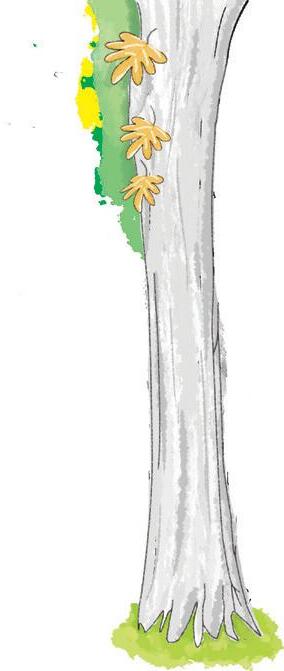

5. Thumb-printing: On page 3, help children dip their thumbs in watercolour or ink. Girls make a thumbprint next to the girl’s picture; boys next to the boy’s picture.







LO: Children will listen to the story Mira’s First Day at School in English and text-to-self connections.
Resources: Literacy Skillbook, pages 1–3
1. Recapitulating: Summarise the story with questions like:
• What did Mira pack in her bag?
• Who drops Mira at school?
2. Interactive Reading-Aloud: Read aloud the story with expressions and voice modulation. Point to the pictures and pause to ask relatable questions. For example:
• Mira packs new crayons in her bag. What do you pack in your schoolbag?
• Mira’s mama drops her to school. Who drops you? Let children answer in their home or mixed language.

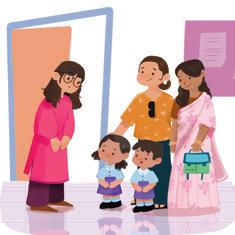



LO: Children will be able to trace right slanting lines, thereby developing their fine motor skills.
Resources: Numeracy Workbook, page 3

1. Right Slanting Line on Board: Draw a large right-slanting line on the board and say: A right-slanting line starts at the top left and goes down to the bottom right, like a slide. Trace on the board as you speak.
2. Air Drawing: Demonstrate right slanting line in the air with your finger. Ask children to trace it in the air 5–7 times.
3. Body Movement: Children mimic the right slanting line with their bodies, stretching one arm up to the left and the other down to the right.
4. Tracing Right Slanting Lines: On page 3, guide children to trace dots of the right-slanting line with their fingers first. Then, let them use a pencil or crayon to trace the lines. Monitor and assist as needed.
Error Alert!











Make sure NOT to confuse the children by giving incorrect directions, such as describing a left-slanting line instead of a right-slanting line. Clearly demonstrate the right-slanting line: It starts from the top left and moves down to the bottom right, NOT the other way round.
LO: Children will listen to the poem Twinkle Twinkle Little Star and repeat it with actions.
Resources: A large cut out of a star, optional audio of the poem
1. Introduction: Show the star cut-out and ask: Do you know what this is? After responses, say: This is a star. Stars are tiny dots in the night sky
2. Singing and Acting: Sing the poem and encourage repetition. Teach simple actions, e.g., Twinkle: Open and close hands. Little star: Point upwards. Repeat 4–5 times.
Let children observe the day sky and ask: Do you see stars now? Stars appear only at night.
Observe the night sky and name the objects you see. Share in class the next day.
Domain
Topic of the Day
Circle Time Setting Classroom Rules
General Awareness Talking About Oneself
Foundational Literacy Story Telling by Children: Mira’s First Day at School Literacy Skillbook, pages 1–3
Foundational Numeracy Left Slanting Lines Numeracy Workbook, page 4
DIY Poem: Twinkle Twinkle Little Star
LO: Children will be able to listen to and understand the classroom rules and follow them.
1. Song of Classroom Rules: Start the day by singing this short song: Come on children, let’s have fun, Let’s have rules for everyone. Repeat this 4–5 times.
2. Introducing Classroom Rules: Ask situation-based questions to encourage thinking, such as:
• What should we do when someone is speaking? Should we interrupt?
• How do we ask for permission to speak?
• Should we hit or kick our friends? Why not?
3. Explaining Classroom Rules: Finally, explain the given classroom rules to children in detail.
Classroom Rules!
1. Listen carefully when someone is speaking.
2. Raise your hand before talking.
3. Keep your hands and feet to yourself.
4. Share toys and other items with your friends.
5. Clean up after eating and playtime.
Feel free to add more classroom rules to the list. Display pictures in the classroom that show the rules to help children remember them.

LO: Children will introduce themselves by sharing their name, age, gender, class, and school. Resources: A soft toy and music (if available)

1. Name, Age and Gender: Revise how to state name, age and gender. Ask different questions to different children and let them answer: What is your name? / What is your age? / Are you a boy or a girl? Help children if they struggle to form sentences.
2. Class: Guide all children to repeat after you: I study in Nursery. Repeat 5–7 times.
3. Name of School: Guide all children to repeat after you: I study in (school’s name). Repeat 5–7 times.
4. Modelling: Guide children how to introduce themselves. Give an example: My name is Varsha. I am 3 years old. I am a girl. I study in Nursery class. I go to Little Blossoms school. Have children repeat line-by-line after you.
5. Passing the Toy: Play music or sing a song while passing a soft toy around. When the music stops, the child holding the toy introduces themselves.
Clap and cheer when a child shares. Use guiding questions if needed.







LO: Children will be able to retell the story Mira’s First Day at School in their home language/mixed language.
Resources: Literacy Skillbook, pages 1–3; drawing sheets with outline of a school bag for all children; crayons
1. Recapitulating the Story: Revise the story with simple questions like:


• What did Mira pack in her bag?
• Who did Mira meet on her first day?
• Who dropped Mira off at school?
• Why was Mira crying?
2. Retelling the Story: Encourage children to retell the story in their own words. Support them by highlighting key events or showing pictures.
3. Colouring the Bag: Give each child a drawing sheet with a school bag outline and let them colour it.




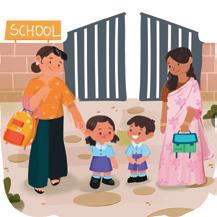
LO: Children will be able to trace left slanting lines, thereby developing their fine motor skills.
Resources: Numeracy Workbook, page 4
1. Seeing Left Slanting Lines: Draw a large left-slanting line on the board and say: This is a left slanting line. It starts at the top right corner and goes down to the bottom left corner, like a slide. Trace on the board as you speak.
2. Air Drawing: Demonstrate left slanting line in the air with your finger. Ask children to trace it in the air 5–7 times.
3. Body Movement: Have children mimic the left slanting line with their bodies, stretching one arm up to the right and the other down to the left.
4. Tracing Left Slanting Lines: Guide children to trace the dots of the left-slanting line on page 4 with their fingers first. Then let them use a pencil or crayon to trace.







Be careful NOT to confuse the children by giving incorrect directions, like starting from the top left side. Clearly demonstrate the left slanting line, starting from the top right and moving down to the bottom left. Error Alert!
LO: Children will sing the poem Twinkle Twinkle Little Star and decorate a star cut-out.
Resources: Star cut-outs and crayons
1. Homework Discussion: Ask children to share what they saw in the night sky.
2. Singing Activity: Sing the poem with actions 3–4 times.
3. Colouring Activity: Give each child a star cut-out and guide them to colour it with their favourite crayon.













Domain General Awareness
Learning Outcome
Children tell their name, age, gender, class and school.
Resources Ice-cream sticks with name for all children
Suggested Method
Support for Struggling Learners
1. Pick a name-stick and ask the child to come forward. Hand them a pretend microphone.
2. Gently guide them with prompts: What is your name? How old are you? Are you a boy or a girl? Which class are you in? What is the name of your school?
3. Clap loudly for each child. Repeat until all children get a chance.
Pair a struggling child with a confident peer (buddy). The buddy can model the answers first, and then the child can repeat after them. For example:
• Buddy says: My name is Mehek
• Child repeats: My name is (child’s name)
Domain Foundational Literacy
Learning Outcome
Children talk about the story Mira’s First day at School and make text-to-self connections.
Resources Literacy Skillbook, pages 1–3
Suggested Method
1. Point to the pictures in the story and ask relatable questions. For example:
• Mira packs new crayons in her bag. What do you pack in your schoolbag?
• Mira’s mama drops her to school. Who drops you?
2. Let children answer in their home or mixed language.
3. Invite a few children to share what they liked the most in the story.
Support for Struggling Learners
Focus on one part of the story at a time (beginning, middle, and end) instead of tackling the whole story at once. Use prompts like, Who was in the story? Or What happened first? to guide them step-by-step.
Domain Foundational Numeracy
Learning Outcome Children will be able to identify standing lines, sleeping lines, right slanting lines and left slanting lines.
Resources Chalk
Suggested Method
Conduct the activity in an open area, if possible.
1. Use chalk to draw a standing line, sleeping line, right slanting line, and left slanting line in a row on the ground.
2. Call one child to the front and name a specific line (e.g., “standing line”). Ask the child to walk and stand near that line. Once the child has identified the correct line, guide them to trace the same line in the air using their finger.
3. Continue the process until all children have had a chance to participate.
Support for Struggling Learners
Provide each struggling child with a sheet that has clear and bold illustrations of a standing line, sleeping line, right slanting line, and left slanting line. Ask them to trace each line using their index fingers, starting from the correct point.

















